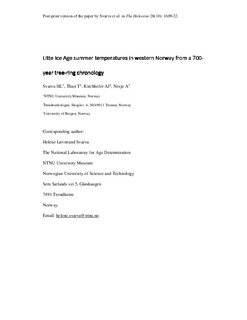| dc.contributor.author | Svarva, Helene Løvstrand | |
| dc.contributor.author | Thun, Terje | |
| dc.contributor.author | Kirchhefer, Andreas | |
| dc.contributor.author | Nesje, Atle | |
| dc.date.accessioned | 2019-04-12T11:24:07Z | |
| dc.date.available | 2019-04-12T11:24:07Z | |
| dc.date.created | 2018-09-15T12:44:45Z | |
| dc.date.issued | 2018 | |
| dc.identifier.citation | The Holocene. 2018, 28 (10), 1609-1622. | nb_NO |
| dc.identifier.issn | 0959-6836 | |
| dc.identifier.uri | http://hdl.handle.net/11250/2594499 | |
| dc.description.abstract | A ring-width Pinus sylvestris chronology from Sogndal in western Norway was created, covering the period AD 1240–2008 and allowing for reconstruction of monthly mean July temperatures. This reconstruction is the first of its kind from western Norway and it aims to densify the existing network of temperature-sensitive tree-ring proxy series to better understand past temperature variability in the ‘Little Ice Age’ and diminish the spatial uncertainty. Spatial correlation reveals strong agreement with temperatures in southern Norway, especially on the western side of the Scandinavian Mountains. Five prominent cold periods are identified on a decadal timescale, centred on 1480, 1580, 1635, 1709 and 1784 and ‘Little Ice Age’ cooling spanning from 1450 to the early 18th century. High interannual and decadal agreement is found with an independent temperature reconstruction from western Norway, which is based on data from grain harvests and terminal moraines. The reconstructed temperatures also correlate with other tree-ring-based temperature reconstructions from Fennoscandia, most strongly with data from central Sweden. Tree growth in Sogndal is correlated to the Scandinavian teleconnection index in the summer months, at least in the last half of the 20th century, and is positively correlated to the summer expression of the North Atlantic Oscillation in the early half of the 20th century. A significant response to major volcanic forcing in the Northern Hemisphere was found, and extreme years seem to be related to the dominance of high and low geopotential height that in turn represents variability in the path of the storm tracks over Fennoscandia. When compared with the variation in frontal positions with time of Nigardsbreen, an eastern outlet glacier from the Jostedalsbreen glacier in western Norway, cold summers in the early 18th century relates to the culmination of a rapid glacial advance that lead up to the 1748 ‘Little Ice Age’ maximum extent. | nb_NO |
| dc.language.iso | eng | nb_NO |
| dc.publisher | SAGE Publications | nb_NO |
| dc.title | Little Ice Age summer temperatures in Western Norway from a 700-year tree-ring chronology | nb_NO |
| dc.type | Journal article | nb_NO |
| dc.type | Peer reviewed | nb_NO |
| dc.description.version | acceptedVersion | nb_NO |
| dc.source.pagenumber | 1609-1622 | nb_NO |
| dc.source.volume | 28 | nb_NO |
| dc.source.journal | The Holocene | nb_NO |
| dc.source.issue | 10 | nb_NO |
| dc.identifier.doi | 10.1177/0959683618782611 | |
| dc.identifier.cristin | 1609770 | |
| dc.relation.project | Norges forskningsråd: 255049 | nb_NO |
| dc.description.localcode | © 2018. This is the authors' accepted and refereed manuscript to the article. The final authenticated version is available online at: https://doi.org/10.1177%2F0959683618782611 | nb_NO |
| cristin.unitcode | 194,31,15,15 | |
| cristin.unitname | Nasjonallaboratoriene for datering | |
| cristin.ispublished | true | |
| cristin.fulltext | original | |
| cristin.qualitycode | 1 | |
